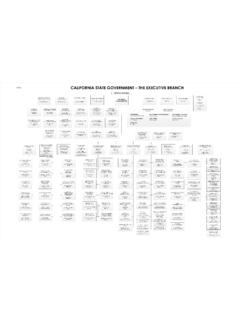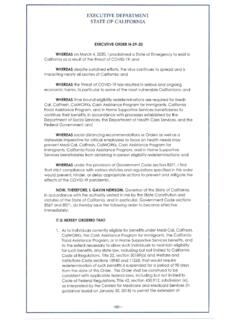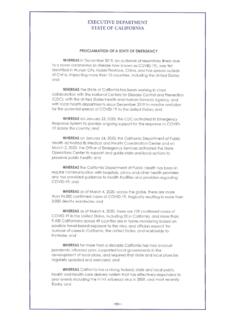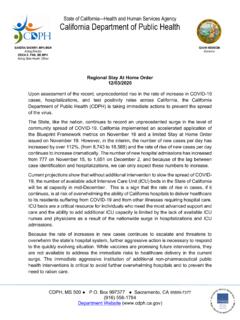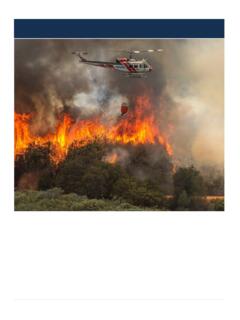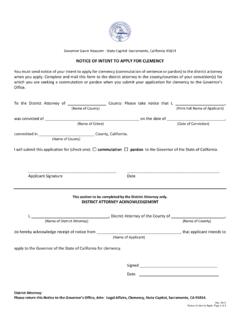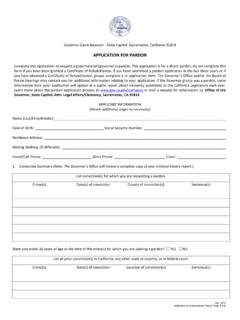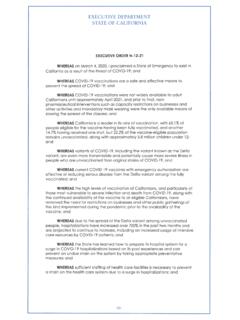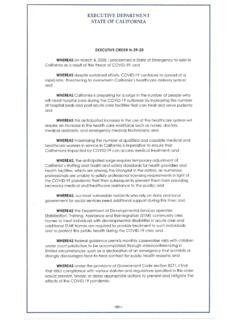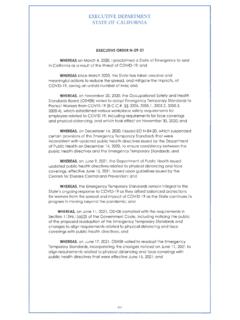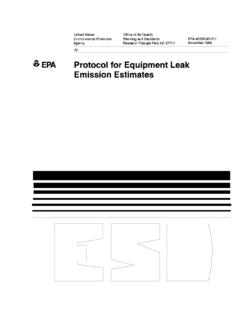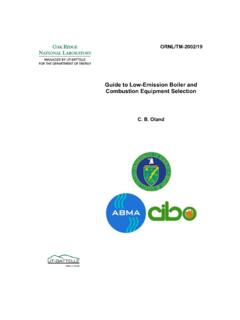Transcription of EXECUTIVE DEPARTMENT STATE OF CALIFORNIA
1 EXECUTIVE DEPARTMENT STATE OF CALIFORNIA EXECUTIVE ORDER N-79-20 WHEREAS the climate change crisis is happening now, impacting CALIFORNIA in unprecedented ways, and affecting the health and safety of too many Californians; and WHEREAS we must accelerate our actions to mitigate and adapt to climate change, and more quickly move toward our low-carbon, sustainable and resilient future; and WHEREAS the COVID-19 pandemic has disrupted the entire transportation sector, bringing a sharp decline in demand for fuels and adversely impacting public transportation; and WHEREAS as our economy recovers, we must accelerate the transition to a carbon neutral future that supports the retention and creation of high-road, high-quality jobs.
2 And WHEREAS CALIFORNIA 's long-term economic resilience requires bold action to eliminate emissions from transportation, which is the largest source of emissions in the STATE ; and WHEREAS the STATE must prioritize clean transportation solutions that are accessible to all Californians, particularly those who are low-income or experience a disproportionate share of pollution; and WHEREAS zero emissions technologies, especially trucks and equipment , reduce both greenhouse gas emissions and toxic air pollutants that disproportionately burden our disadvantaged communities of color; and WHEREAS CALIFORNIA is a world leader in manufacturing and deploying zero-emission vehicles and chargers and fueling stations for cars, trucks, buses and freight-related equipment .
3 And WHEREAS passenger rail, transit, bicycle and pedestrian infrastructure, and micro-mobility options are critical components to the STATE achieving carbon neutrality and connecting communities, requiring coordination of investments and work with all levels of governments including rail and transit agencies to support these mobility options; and WHEREAS CALIFORNIA 's policies have contributed to an on-going reduction in in- STATE oil extraction, which has declined by over 60 percent since 1985, but demand for oil has not correspondingly declined over the same period of time; and WHEREAS CALIFORNIA is already working to decarbonize the transportation fuel sector through the Low Carbon Fuel Standard, which recognizes the full life cycle of carbon in transportation emissions including transport into the STATE .
4 And WHEREAS clean renewable fuels play a role as CALIFORNIA transitions to a decarbonized transportation sector; and WHEREAS to protect the health and safety of our communities and workers the STATE must focus on the impacts of oil extraction as it transitions away from fossil fuel, by working to end the issuance of new hydraulic fracturing permits by 2024; and WHEREAS a sustainable and inclusive economic future for CALIFORNIA will require retaining and creating high-road, high-quality jobs through sustained engagement with communities, workers and industries in changing and growing industries.
5 NOW THEREFORE, I, GAVIN NEWSOM, Governor of the STATE of CALIFORNIA by virtue of the power and authority vested in me by the Constitution and the statutes of the STATE of CALIFORNIA , do hereby issue the following Order to pursue actions necessary to combat the climate crisis. IT IS HEREBY ORDERED THAT: 1. It shall be a goal of the STATE that 100 percent of in- STATE sales of new passenger cars and trucks will be zero-emission by 2035. It shall be a further goal of the STATE that 100 percent of medium-and heavy-duty vehicles in the STATE be zero-emission by 2045 for all operations where feasible and by 2035 for drayage trucks.
6 It shall be further a goal of the STATE to transition to 100 percent zero-emission off-road vehicles and equipment by 2035 where feasible. 2. The STATE Air Resources Board, to the extent consistent with STATE and federal law, shall develop and propose: a) Passenger vehicle and truck regulations requiring increasing volumes of new zero-emission vehicles sold in the STATE towards the target of 100 percent of in- STATE sales by 2035. b) Medium-and heavy-duty vehicle regulations requiring increasing volumes of new zero-emission trucks and buses sold and operated in the STATE towards the target of 100 percent of the fleet transitioning to zero-emission vehicles by 2045 everywhere feasible and for all drayage trucks to be zero emission by 2035.
7 C) Strategies, in coordination with other STATE agencies, Environmental Protection Agency and local air districts, to achieve 100 percent zero-emission from off-road vehicles and equipment operations in the STATE by 2035. In implementing this Paragraph, the STATE Air Resources Board shall act consistently with technological feasibility and cost-effectiveness. 3. The Governor's Office of Business and Economic Development, in consultation with the STATE Air Resources Board, Energy Commission, Public Utilities Commission, STATE Transportation Agency, the DEPARTMENT of Finance and other STATE agencies, local agencies and the private sector, shall develop a Zero- emissions Vehicle Market Development Strategy by January 31, 2021 , and update every three years thereafter, that.
8 A) Ensures coordinated and expeditious implementation of the system of policies, programs and regulations necessary to achieve the goals and orders established by this Order. b) Outlines STATE agencies' actions to support new and used zero emission vehicle markets for broad accessibility for all Californians. 4. The STATE Air Resources Board, the Energy Commission, Public Utilities Commission and other relevant STATE agencies, shall use existing authorities to accelerate deployment of affordable fueling and charging options for zero-emission vehicles, in ways that serve all communities and in particular low-income and disadvantaged communities, consistent with STATE and federal law.
9 5. The Energy Commission, in consultation with the STATE Air Resources Board and the Public Utilities Commission, shall update the biennial statewide assessment of zero-emission vehicle infrastructure required by Assembly Bill 2127 (Chapter 365, Statues of 2018) to support the levels of electric vehicle adoption required by this Order. 6. The STATE Transportation Agency, the DEPARTMENT of Transportation and the CALIFORNIA Transportation Commission, in consultation with the DEPARTMENT of Finance and other STATE agencies, shall by July 15, 2021 identify near term actions, and investment strategies, to improve clean transportation, sustainable freight and transit options, while continuing a "fix-it-first" approach to our transportation system, including where feasible.
10 A) Building towards an integrated, statewide rail and transit network, consistent with the CALIFORNIA STATE Rail Plan, to provide seamless, affordable multimodal travel options for all. b) Supporting bicycle, pedestrian, and micro-mobility options, particularly in low-income and disadvantaged communities in the STATE , by incorporating safe and accessible infrastructure into projects where appropriate. c) Supporting light, medium, and heavy duty zero-emission vehicles and infrastructure as part of larger transportation projects, where appropriate.
